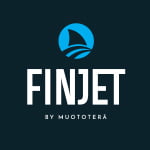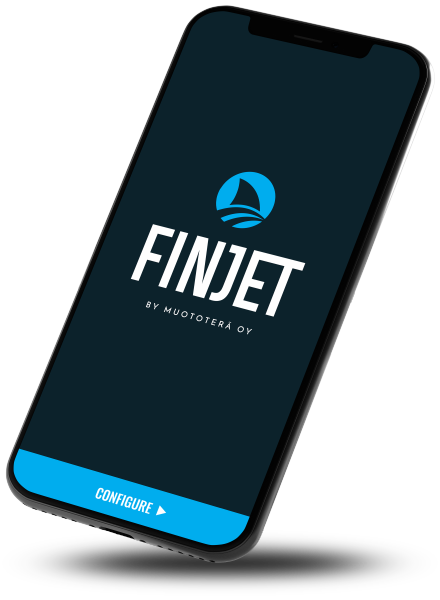Waterjet cutting process
Depending on the material, a mixture of water and an abrasive substance can be used. Mixture of water and abrasive is used to cut hard materials such as metal or stone, while the pure water cutting is often used for softer materials such wood, plastic or rubber. This is called abrasive waterjet cutting but sometimes also referred only as waterjet cutting.
In practice all materials from one end to another. Tempered glass or materials with zero water tolerance cannot be cut. Most common materials for water jet cutting are aluminum, steel, iron, plywood, textiles, copper, bronze, porcelain, cardboard, composites, foams, insulation materials, stone, glass, carbon fiber, plastic, rubber, glass fiber, plex glass, tiles and bricks.
Yes, bevel cutting is possible. This requires that the waterjet cutting machine is equipped with a 5-axis cutting head. Muototerä uses on their own subcontracting water cutters that enables 56-degree angles. We have built waterjet cutting systems with up to 90-degree cutting angle.
Yes, stack cutting is possible. Water jet cutting is a non-thermal cutting method, so there is no risk that the parts would weld to each other due to thermal effects.
Depending on the material and cutting parameters (pure water or abrasive water jet cutting), typical cutting kerf ranges between 0.10 – 1.0 mm.
Water jet cutting machines manufactured by Muototerä, have maximum speed of either 40/100 m / min (pure water cutting machine) or 15 m / min (abrasive cutting). Different materials and thicknesses have different cutting speeds. For example, a 20 mm thick aluminum can be cut to approximately 130 – 600 mm per minute (3800 bar, the abrasive 350g / min), depending on the desired quality of surface. Cutting speed with pure water e.g. for plywood (6,5mm thick) is 5000 mm / min and e.g. 100 mm insulation wool can be cut with a maximum speed of 40 m / min.
The slower the waterjet is driven, the smaller the cone is formed. Eventually it will turn into negative by reducing the speed. The conicity is typically 0.05 – 0.2 mm, but with right parameters it can be close to zero. 5-axis cutting heads can be compensate conicity by turning the cutting head. This way the conicity can be minimized even with higher cutting speeds and in some cases removed completely.
Water jet cutting machine’s positioning and repeat accuracy is typically ±0.025 – 0.10 mm. The actual cutting accuracy depends on many factors: the material and cutting parameters (pressure, speed, type and amount of abrasive / min), the condition of wear parts of the machine, and the cutting table planarity (= wearing component). A typical cutting precision as measured from the upper surface of the piece is about ± 0.05 – ± 0.2 mm.
The quality of the surface is commonly expressed in the classification 1-5:
Waterjet cutting machines
Typical installation includes cutting table, control desk, high pressure pump, abrasive silo, electrical cabinet and waste removal system. The required foot print is affected by the size of the cutting table and the selected additional equipment. The smallest table needs only 3 x 3m area.
Most common abrasive quality is 80 mesh. 120 mesh is used for example cutting glass. Muototerä can give recommendations about the garnet abrasive depending on the application.
Principally yes, but we do not recommend this. There are equipment available for recycling, but the process is highly energy consuming and the total cost of the process might be higher than using new abrasive. The cutting power of recycled abrasive is not as good as for new abrasive, while the sharp edges of the particles have been worn out.
The best way to remove the abrasive from the cutting tank is to use the waste removal system from Muototerä. It will pump the abrasive into a big bag, the same bag where the abrasive was delivered. The system is driven by reliable pneumatically driven diaphragm pump which have been developed specially for handling abrasive and liquids. When the bag is full, it can be taken out and delivered to local waste deposit.
Maximum pressure is 6200 bar. Typically used pressure level is approx. 3300 – 4200 bar.
One 50 hp (37kW) pump uses approx. 2 – 4 litres per minute for cutting. The pump uses water also for cooling, if there is no oil-air heat exchanger in use. Cooling water consumption is approx. 3-15L per minute depending on water and room temperature, as well as the usage of the pump.
Normally the tap-water is good enough for cutting. There are certain qualifications for the water quality, which can be used for quality assessment. If the water is too hard, it can cause abnormal wearing in high pressure components. It is strongly recommended to take a water analyze before installing a system. The result gives us important information when choosing appropriate water treatment system. The pressure of the supply water should be constant min. 3.5 bar. Where pressure fluctuations occur in the public water supply, the system should be equipped with water reserve tank and constant pressure pump. The constant supply of high quality water to the high pressure pump prolongs the service life of wear parts in the intensifier.
The most wearing parts are the nozzles. Every cutting head has a water orifice, and a focusing tube (abrasive nozzle), if abrasive is used. The water orifice can be a sapphire nozzle with an average lifetime of 40h, or a diamond with lifetime of 500 – 1000h or even more. Focusing tube has an average lifetime of 100 – 200h. The lifetime of both nozzles is affected by the cutting parameters.
The high pressure pump should have a yearly maintenance service. Between the yearly services, there may be need for changing sealings or check valve components. Lifetime for a sealing is typically 500-1000 hours, and it is affected by used pressure level, water quality and service actions (cleanness). The system should be checked daily for detecting leaks and testing the safety equipment. Change of nozzles is typical service task for a user.
Typical value for abrasive feed is 180 – 600 g per minute. It is always optimized for means of cutting quality, speed and economy.
The cutting program contains the data needed for cutting task. It will be created by IGEMS-software according a ready CAD-file or using drawing commands like Autocad. The programs can be transferred to cutting table control via Ethernet or USB-memory. If there is only a drawing on paper, it can be scanned to a JPG-picture and imported to programming software.
The most important issue is to consider the overall economy of the lifetime costs. When planning the investment, it would be good to estimate the using hours per week and list different kind of types of use. This helps for planning the costs and service / spare part practices. A waterjet cutting system made by Muototerä has a lifetime of 15-25 years, so it is not only the purchase price that counts. It means in other words that the cheapest system may not be the best solution. If there is poor service and support available, or if there are not all the needed spare parts available, it may result high cost regarding the lifetime of the system. Assuming the lifetime is 15 years for abrasive cutting with 37kW pump, the estimated costs are divided as follows:
Operator cost 51 %
Abrasive cost 15 %
Purchase price 14 %
Service / spare parts 12 %
Electricity and water 8 %
Due to the reason that the operator cost is the biggest cost, it is essential to make sure that the operators are trained properly and have appropriate tools for working efficiently. This can be achieved by professional training and easy to use control and software. Muototerä has been developing these key factors for a long time.
Basic training is done by skilled professionals and the helpdesk is always available. The systems and additional equipment are also designed so that unmanned production can be used.
Muototerä designs the systems so that the usability is the main driver. We test the new functions first though in our own subcontracting production before launching them on the market. It gives as possibility to adjust the design so that the user feedback has been counted. Muototerä has wide range of spare parts available for quick deliveries and has strong experience on service for waterjet cutting systems. This is very important issue when aiming to minimize the downtime on cutting machines. The most expensive hours are those, when the system is not available for cutting.
Waterjet cutting can be used for almost all materials. It covers also materials, which cannot withstand heat. As a non-thermal cutting method, waterjet cutting will not create any thermal changes to the material. This is an important benefit, when cutting steels and aluminium. There are no restrictions for the hole size like in plasma cutting and the holes are round shaped. Water jet cutting system can have several cutting heads, which will multiply the productivity. With water cutting there is no need to use any cutting gas.







